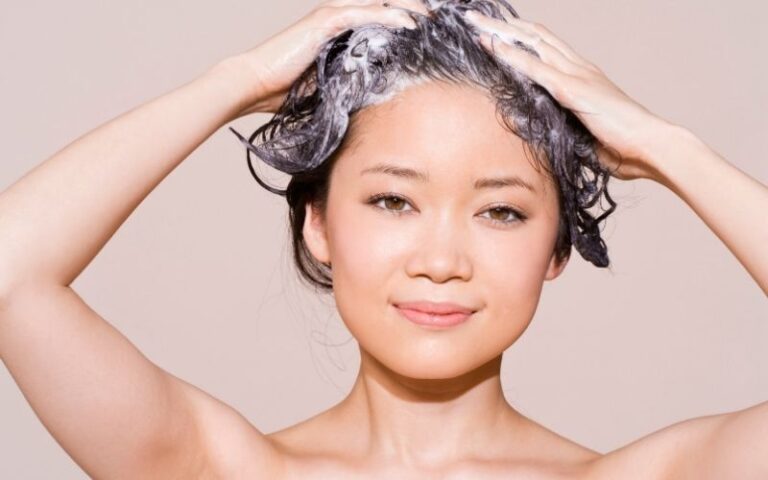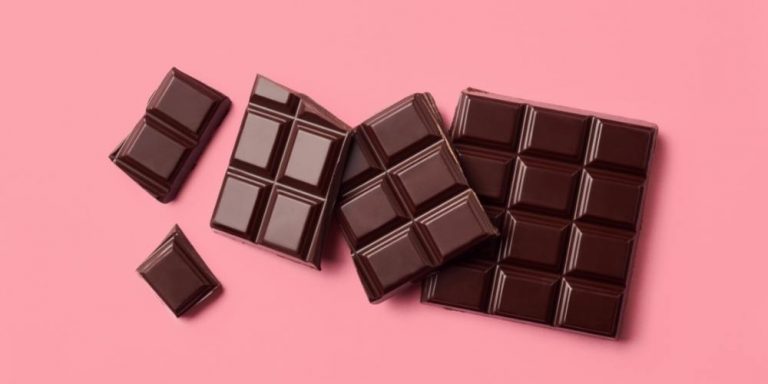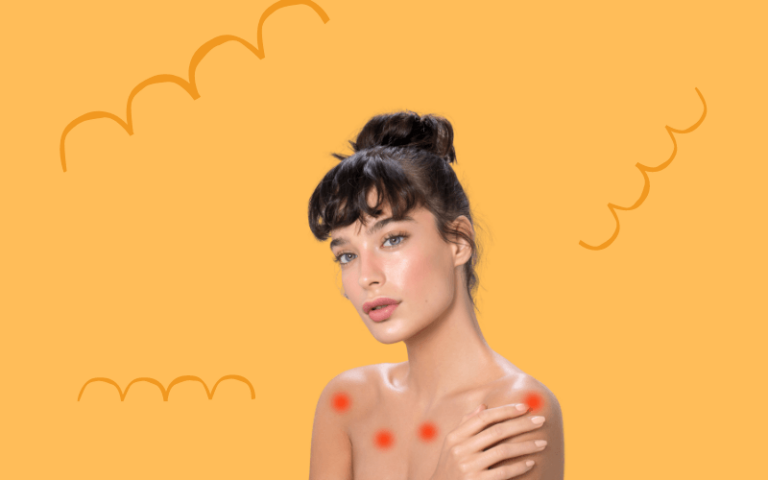Typical Acne Routines Don’t Work If You Have Fungal Acne

Many of us have come to face the unsettling (okay, annoying) fact that acne is not just for teenagers in puberty anymore.
We all just want to know how to get clear skin, is that really too much to ask for?
And to make it even more lovely, no one ever taught us that our newest breakout, or cluster of pimples, could very well not be our typical acne breakout after all.
To make matters worse, your typical acne treatment medications won’t do a thing for this type of stubborn breakout.
So before you start blindly treating what you think is your everyday acne breakout, let me introduce you to the very real, very sneaky, form of acne commonly known as fungal acne.
What is fungal acne and do you have it?
Fungal acne, or Pityrosporum folliculitis, is a type of acne/rash-like breakout that is different than acne caused by hormones/hormone imbalance and is actually caused by an imbalance of or overgrowth of yeast which causes these acne-like eruptions.
The most common type of yeast to cause Pityrosporum folliculitis, also known as Malassezia folliculitis (MF), is actually yeast that naturally lives on our skin, Malassezia furfur.
Malassezia is often found in the stratum corneum, the outermost layer of the epidermis.
When you have excess yeast production, you may begin to develop tiny millimeter papules (red or pink bumps) and pustules (red or pink bumps with a pocket of pus) on your body that are likely causing an itching effect.
This is due to a yeast infection of the hair follicle.
When caused by a fungal infection like MF, these acne-like bumps are typically found on the back, chest, neck, shoulders, upper arms, and possibly on the face.
If you are noticing clusters of little bumps with inflammation located on your forehand, back, chest, posterior arms, and shoulders that all look similar and are very itchy, you may fungal acne.
One way you can possibly determine if you do have this kind of medical condition is if your typical over-the-counter regular acne treatments are not helping improve these stubborn little bumps.
Also important to note: this type of fungus is typically found on young adults or adolescents.
What causes fungal acne?
So, now you may be wondering what in the world causes someone to get this deceptive form of acne.
The short answer is, it depends!
But in case you’re curious, here’s the long answer:
Your skin has its own microbiome that contains different types of bacteria and fungi that naturally live on your skin.
Most of the organisms that compose your skin’s microbiome do not harm you and can even be helpful for your skin.
In certain situations, you can experience an improper balance of bacteria/fungi on your skin which can lead to different conditions, like MF, or fungal acne.
Oral antibiotics
A common cause of MF is taking oral antibiotics.
When you take oral antibiotics or steroids for an infection, you may actually alter your normal skin flora we were just talking about.
When that happens after taking an antibiotic, you may be allowing yeast overgrowth, from a yeast that naturally lives on your skin, to occur.
When that yeast overgrowth occurs, you may experience MF.
Now you may be thinking, “I have a healthy immune system, I’m active, and I’m a workout junkie, why am I getting this condition?”You may have just answered your own question.
Sweaty, moist environments
Malassezia folliculitis, or MF, is much more likely to occur in hot, sweaty, humid environments.
These humid climates are the perfect set up for yeasts, like Malassezia, to grow at a higher rate.
To top it off, your favorite workout top or sports bra may be adding to that humidity that yeast feed off of.
Wearing tight clothes/restrictive clothing can cause occlusion of the hair follicles, and a wet and humid environment, which can lead to an overgrowth of yeast and skin irritation.
Excessive sweating, humid areas, wet environments, extra moisture, and wearing tight sweaty clothes for long periods of time, all create an environment that’s prone to yeast growth.
Sticking to looser clothes with more breathable fabrics for preventive measure can help you easily avoid this culprit.
Other fungal acne suspects
Different products that are high in fatty acids also can be the cause of fungal acne.
Fatty acids create an extremely fungus-prone environment.
Like many other skin conditions, at the end of the day, some people are just more genetically predisposed than others to getting MF.
People that have systemic diseases such as diabetes, HIV, or that are pregnant, may be at an increased risk of getting fungal acne.
It is also possible that diet changes or hormonal changes could cause acne breakouts.
How to get rid of fungal acne
Ahem, fungal acne doesn’t stand a chance against a rock-solid routine…
Check your skincare routine
When thinking about how to treat fungal acne, a good first step is to take a good look at your skincare routine.
Many skin care products that aim to increase hydration of your skin could actually be the culprit feeding MF.
Fancy facial oils may be tempting to add on as one of your typical products, however, chances are you don’t actually need them AND they may be causing an infection of hair follicles.
Always opt for oil-free moisturizer/lotion if you have fungal acne.
Cerave and Cetaphil are both great brands to consider for breakout-free products.
When your hair follicles become blocked, or occluded, this creates an environment that yeast thrives in.
Yeast also thrives in an oily environment which leads to overgrowth.This oily environment could be caused by eccessive oil production from your sebaceous glands, called sebum, or oil from products, typically in the form of fatty acids.
Fatty acids
Let’s talk about fatty acids.
Skin care products that contain essential fatty acids such as omega-3 and omega-6 polyunsaturated fatty acids could be increasing your chances of getting MF.
If you have a history of MF and are hoping to decrease your chances of getting fungal acne at all causes, start with avoiding products that contain fatty acids.
Watch out for products with fatty acids such as linoleic, palmitic, and stearic.
You may also want to avoid products that contain lauric acid which is the main fatty acid that is found in coconut oil.
That being said, definitely avoid applying coconut oil or olive oil (both full of fatty acids) to your face if you are hoping to avoid, or have a history of, MF!
Remember, fungus thrives in a lot of oil and we want to keep that fungus out of our follicles!
For facial fungal acne
Try saying that five times fast.
If you think you may have fungal acne on your face, there are some over-the-counter acne treatments you can try before you make an appointment with your healthcare provider.
Dandruff shampoo
Dandruff shampoos don’t only work to cure dandruff!
Many over-the-counter dandruff shampoos will be the first line of defense in treating MF.
Shampoos that contain active ingredients such as zinc pyrithione, selenium sulfide, and ketoconazole, which are active ingredient and work as antifungals in a topical treatment setting.
These ingredients which are found in several over-the-counter dandruff shampoos, can be used as face cleansers to help treat or prevent, MF.
These dandruff shampoos which contain the active ingredients mentioned above such as pyrithione zinc are often used to treat other common fungal/yeast skin infections such as seborrheic dermatitis.
This is a yeast infection that typically affects the scalp and face, or tinea versicolor, which is often found on the trunk.Using products that contain benzoyl peroxide or salicylic acid, in combination with a dandruff shampoo, can help keep pores clean in hopes of treating or preventing fungal breakouts.
When using a dandruff shampoo, such as Selsun blue or Nizoral, the best way to use it is to apply it to the face and allow it to sit for a few minutes while you sing the alphabet song before rinsing.
This multi-step process allows the shampoo’s active ingredients to be most effective and do their job.
If you are actively experiencing a fungal breakout, you may consider using dandruff shampoo as a face cleanser daily until clear.
You may also decide to use a dandruff shampoo containing one of these active ingredients as a face wash 1-2 times per week as a topical treatment in hopes of avoiding future fungal breakouts.
For body fungal acne
When treating MF, the skin on the face and the skin on the body can, and should, be treated differently with the right products.
One of the main differences between the skin on your face and the skin on your body is the thickness of your skin.
The outermost layer of your skin, the epidermis, is much thinner on the face compared to most other parts of the body and this can help you determine which antifungal wash to use where.
Since the skin on your body is thicker and stronger than the skin on your face, you may need stronger antifungal body wash to help treat MF such as 5% benzoyl peroxide cleanser.
You can also try creams that are used for athlete’s foot because they typically contain antifungal properties that fight off the same type of fungus.
Fortunately, there are also some simple changes you can make to prevent fungal breakouts such as:
- Changing your sweaty workout clothes as soon as possible.
- Wearing breathable fabrics whenever possible
Try exfoliating
The next step you may want to consider is exfoliating.
Having a clogged follicle from dead skin cells, product residue, and dirt can increase the growth of yeast on our skin.
This can also help to regulate your sebum production.
If you’re hoping to treat or prevent MF, try incorporating exfoliating your body with a physical or chemical exfoliant into your skincare routine.
A great time to do this is after a sweaty workout or when you are in extra humid conditions!
While physical exfoliators are an option, they are not the only way.
Chemical exfoliators in the form of prescription skincare products, such as tretinoin, may be helpful also with helping get rid of excess oil and dead skin.
Other possible solutions
When treating fungal acne breakouts, another topical option that could help improve this skin condition is tea tree oil.
Tea tree oil has natural anti-fungal properties and when used correctly, could be an effective treatment.
Be sure to apply this topically, not orally, and make sure you dilute the tea tree oil to decrease the risk of irritation and sensitivity.
You may want to apply a small amount of your tea tree oil mixture to somewhere like your arm to ensure you won’t have an allergic reaction.
As mentioned before, your cosmetic dermatologist may prescribe you an oral antifungal treatment, such as fluconazole, to help eradicate the infection of the hair follicle.
Oral antifungal medication typically leads to rapid improvement of your fungal acne breakout.
Another way you can possibly help prevent fungal acne breakouts is by implementing some lifestyle changes, including your diet for maintenance treatment.
If you need yet another reason to limit food with sugary carbohydrates, yeast and fungi love them too, so, it’s best to limit them whenever possible.
Instead, try a balanced diet with protein, fruits, whole grains, and vegetables.Your skin (and body) will appreciate it big time!
Fungal acne vs. bacterial acne
Fungal acne can definitely be sneaky and difficult to tell apart from the better known bacterial acne (aka the typical blemish), or acne vulgaris.
Certain clues can differentiate the two:
Similarities
Both fungal acne and acne vulgaris alter your skin’s complexion and appearance with redness and bumps on the skin.
They both can be present on the back, chest, arms, and cheeks.
Both fungal acne and traditional acne can worsen when wearing tight sweaty clothes after your workout.
They both can consist of red skin lesions, called papules, and red bumps with a little pocket of pus called pustules.
Key differences
Even though they may look similar, fungal acne and traditional acne are very different forms of acne.
A big difference between fungal acne and bacterial acne is that fungal acne tends to be associated with itchiness while bacterial acne is rarely itchy and rather painful and involves skin bacteria.
You will also likely see different types of skin lesions with bacterial acne, such as blackheads, whiteheads, and cysts, that are not typically present with fungal acne.
Another way to tell the difference between fungal and regular acne is by trying your usual acne treatments.
If it doesn’t work, there’s a chance you may be dealing with fungal acne and you may need to try other treatment options.
Fungal acne location
One bright side of fungal acne is the typical affected areas.
MF tends to show up on areas of the skin that are usually covered up by clothing.
Thank goodness for that!While “regular acne”, or acne vulgaris, is often located on the cheeks and forehead, fungal acne typically avoids these areas.
Fungal acne, or MF, is usually found on the back, chest, shoulders, upper arms, and sometimes the neck.
Bacterial acne, or “traditional acne/real acne” can be found in these areas as well, so they may be difficult to tell apart without seeing a healthcare provider.
It is important to note that fungal acne can occur on the cheeks and forehead, but it most often sticks to the back, chest, shoulders, upper arms, and upper chest.
When to see a dermatologist
Depending on the severity of the infection of fungal acne and if you aren’t seeing any improvement, it is probably time to seek professional medical advice.
Your dermatologist can confirm the diagnosis of this type of infection and make a proper treatment plan to combat your skin condition using antifungal medication.
They may put you through a physical exam, skin biopsy, or skin scraping to attempt to confirm the diagnosis using a microscope.
They also have access to prescription-strength antifungal medication or other acne medications that can help treat your overgrowth of fungus effectively.
They will likely prescribe an oral antifungal medication treatment such as oral fluconazole or itraconazole to eradicate your MF.
In extreme cases, anti-inflammatory medications such as prednisone may be prescribed.
However, this is unlikely for a mild case.
Traditional treatments may include a topical antifungal cream, like those used to treat athlete’s foot, such as ketoconazole or clotrimazole, to apply directly to your skin.
Once your condition has resolved, your dermatologist may recommend using an antifungal shampoo, such as ketoconazole shampoo, as a body wash in the shower 1-2 times per week to prevent a recurrence.
When in doubt, don’t wait! Make an appointment at your local dermatology office for more help.
How fast can I rid fungal acne?
For this type of infection, timeframes may vary as to how fast you can get rid of it, especially if not treated properly.
If treated effectively, fungal acne can go away very quickly.
If you’re treating with over-the-counter products, it will likely take longer for MF to go away versus treating MF with oral antifungals and prescription-strength topical antifungals.
Once the lesions experience a significant reduction, your dermatologist will likely have you discontinue the antibiotics.
Recurrence is common after discontinuing your oral antifungal medication, so your dermatologist will likely have you continue some form of topical antifungal to decrease the risk of recurrence.
Fungal acne key takeaways
While no one wants to have a fungal acne breakout, the good news is there are several options for treatment!
Let’s wrap this up with some key points about this common skin condition, Pityrosporum or Malassezia folliculitis, that you’ll definitely want to remember:
- Malassezia or Pityrosporum folliculitis, also known as fungal acne, is a type of acne-like breakout that is actually caused by an overgrowth of yeast.
- Common causes of MF include oral antibiotic use, wearing tight or sweaty clothes, being in humid weather, and having a disorder that causes immunosuppression.
- Fungal acne can mimic regular bacterial acne. Pay close attention to the location, symptoms associated, types of lesions (only red bumps versus a mixture of red bumps, blackheads, and whiteheads), and if it improves with your typical acne vulgaris acne medication to see if it is more likely fungal or traditional acne.
- There are several over-the-counter medications for Pityrosporum folliculitis such as anti-dandruff shampoos with zinc pyrithione, selenium sulfide, and ketoconazole, and benzoyl peroxide washes, and salicylic acid products.
- You may want to avoid products that contain fatty acids such as skincare products that include coconut oil. Also, definitely avoid applying olive oil to your face, which is full of fatty acids, if you are hoping to avoid, or have a history, of MF!
- Tea tree oil and lifestyle changes are both other possible options for improving your fungal folliculitis.
- When in doubt, go see your dermatology provider. They can confirm your diagnosis and prescribe oral medication, like antifungals, such as fluconazole, and topical antibiotics, such as ketoconazole, to help.
Remember, you are not alone!Many people have struggled with fungal acne and have overcome it.As always, don’t hesitate to make an appointment with your derm if you have any questions or concerns!
+3 Sources
- Grice EA, Segre JA. The skin microbiome [published correction appears in Nat Rev Microbiol. 2011 Aug;9(8):626]. Nat Rev Microbiol. 2011;9(4):244-253. doi:10.1038/nrmicro2537
- Rubenstein RM, Malerich SA. Malassezia (pityrosporum) folliculitis. J Clin Aesthet Dermatol. 2014;7(3):37-41.
- Pinney S. (2020). Medscape (v7.7.2) [Mobile application software]. Retrieved from URL.





